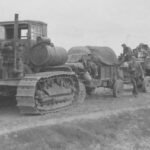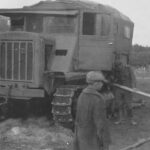Soviet Artillery Tractors
53 photos
During World War II, Soviet artillery relied heavily on specialized tractors, often referred to as „Tyagatshi” (тягачи), to pull its vast array of towed artillery pieces, ranging from light field guns to massive heavy howitzers. Given the often unpaved and challenging terrain of the Eastern Front, tracked vehicles were particularly prevalent and essential for mobility. Soviet artillery tractors of WWII included:
STZ-5: This tracked tractor, produced by the Stalingrad Tractor Factory from 1937 to 1942, was the most numerous purpose-built Soviet military tractor. It was designed to tow division to corps-level guns (up to 8 tons) and was praised for its reliability and good cross-country ability, despite some critiques regarding its power in extreme mud or snow. Some STZ-5 chassis were even adapted to carry BM-13 „Katyusha” rocket launchers.
Komintern: Developed in the early 1930s, the Komintern was a heavy tracked artillery tractor based on the suspension of the T-24 tank. Powered by a 131 hp engine, it could tow medium artillery like the 152 mm gun-howitzer. Around 1,800 were produced between 1934 and 1940, known for their pulling power and robustness, though they consumed a lot of fuel.
Voroshilovets: An even more powerful heavy tracked prime mover, the Voroshilovets was introduced in 1939 as a successor to the Komintern, also based on a tank chassis (T-24 derived). With a more potent 375 hp diesel engine, it could tow the heaviest Soviet artillery pieces, including the 203 mm B-4 howitzer and 280 mm Br-5 mortar. Its tracked chassis provided excellent all-terrain mobility, vital for the vast and often difficult Russian landscape.




















































